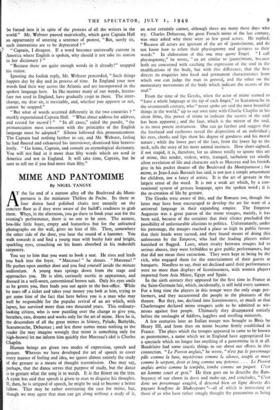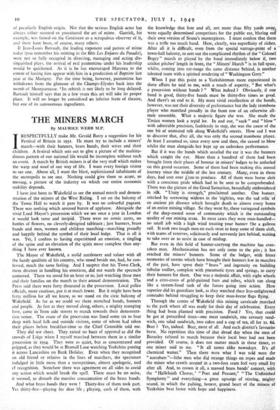MIME AND PANTOMIME
By NIGEL TANGYE
ATthe far end of a narrow alley off the Boulevard du Mont- parnasse is the miniature Theatre de Poche. Its three or four dozen hard polished chairs rest uneasily on the concrete floor as if they were aware of the bailiff's readiness to grab them. When, in the afternoon, you go there to book your seat for the evening's performance, there is no one to be seen. The austere, box-like little foyer, empty and featureless but for the unframed photographs on the wall, gives no hint of life. Then, somewhere the other side of the door, you hear the sound of a hammer. You walk towards it and find a young man with bushy hair and bright, sparkling eyes, crouching on his knees absorbed in his makeshift carpentry.
You say to him that you want to book a seat. He rises and leads you back into the foyer. " Marceau! " he shouts. "Marceau! " He pushes open another door and you find yourself inside the minute auditorium. A young man springs down from the stage and approaches you. He is slim, curiously ascetic in appearance, and dressed in a well-worn, conventional brown suit. Only his eyes smile as he greets you, then leads you out again to the box-office. While he tears off a ticket and takes your money you look at him, trying to get some hint of the fact that here before you is a man who may well be responsible for the popular revival of an art which, with lapses, has survived more than two thousand years. This ordinary- looking citizen, who is now puzzling over the change to give you, breathes, eats, dreams and works only for the art of mime. Here he is, the descendant of all the great mimes in history, Pylade, Bathylde, Scaramouche, Deburcau ; and lest those names mean nothing to the reader (he may imagine wrongly that mime is something only for high-brows) let me inform him quickly that Marceau's idol is Charles Chaplin.
Human beings are given two modes of expression, speech and gesture. Whereas we have developed the art of speech to cover every nuance of feeling and idea, we ignore almost entirely the study of the gesture as a means of thought transmission. One may say, perhaps, that the dance serves that purpose of study, but the dance is to gesture what the song is to words. It is the flower on the tree. A cynic has said that speech is given to man to disguise his thoughts. If, then, he is stripped of speech, he might be said to become a better fellow. That may be rather overstating the case for mime, but, though we may agree that man can get along without a study of it, an actor certainly cannot, although there are many these days who try. Charles Dehureau, the great French mime of the last century, was once asked why there were so few good actors. He replied, " Because all actors are ignorant of the art of (panto)mime, and do not know how to relate their physiognomy and gestures to their words." In elaboration of this one may quote Engel. " I call physiognomy," he wrote, "an art similar to (panto)mime, because both are concerned with catching the expression of the soul in the modifications of the body, but with this difference, that the first directs its enquiries into fixed and permanent characteristics from which one can judge the man in general, and the other on the momentary movements of the body which indicate the secrets of the soul."
From the time of the Greeks, when the actor of mime seemed to "have a whole language at the tip of each finger," to Scaramouche in the seventeenth century, who " never spoke yet said the most beautiful things in the world," up to our own time with Charlie Chaplin in his silent films, this power of mime to indicate the secrets of the soul has been apparent ; and the face, which is the mirror of the soul, is its most potent instrument. One can go further and suggest that the forehead and eyebrows reveal the disposition of an individual ; his eyes, cheeks and lips show his degree of goodness and his moral nature ; while the lower part of the face, from the lower lip to the neck, tells the story of his more animal instincts. How short-sighted, if not stupid, it is, therefore, for us almost totally to ignore this art of mime, this tender, violent, witty, tranquil, turbulent yet wholly silent revelation of life and character such as Marceau and his friends give in his pocket theatre off the Boulevard du Montparnasse ; for mime, as Jean-Louis Barrault has said, is not just a simple amusement for children, nor a fancy of artists. It is the art of gesture in the largest sense of the word. It is not a weak art which, by a con- ventional system of gesture language, apes the spoken word ; it is the re-creation of life by gesture.
The Greeks were aware of this, and the Romans too, though the latter may have been encouraged to develop the art for want of a universal language in their expanding empire. The Emperor Augustus was a great patron of the mime troupes, mainly, it has been said, because of the certainty that their silence precluded the possibility of unfavourable allusions to politics. Unfortunately, under his patronage, the troupes reached a place so high in public favour that their heads were turned, and they found means of doing this unforeseen by the Emperor, who had the leading players either banished or flogged. Later, when rivalry between troupes led to serious abuses, they were forbidden to give public performances, but that did not mean their extinction. They were kept in being by the rich, who engaged them for the entertainment of their guests at banquets. Needless to say, their art declined until their performances were no more than displays of licentiousness, with women players imported from Asia Minor, Egypt and Spain.
In the sixth century they appeared for the first time in France at the Saint-Germain fair, which, incidentally, is still held every summer. For a long time the players in this troupe were the only stage per- formers, and they accustomed the people to the pleasures of the theatre. But they, too, declined into licentiousness, so much so that Charlemagne declared mime troupers unfit to be admitted as wit- nesses against free people. Ultimately they disappeared entirely before the onslaught of fiddlers, jugglers and strolling minstrels.
A few centuries later an Italian troupe was brought to Blois by Henry III, and from then on mime became firmly established in France. The plays which the troupes appeared in came to be known as pantomimes, a name which we in England have appropriated for a spectacle which no longer has anything of a pantomime in it at all. Baudelaire had some caustic things to say about our efforts in this connection. "Le Pierrot anglais," he wrote, "n'est pas le personnage pale comme la lune, mysterieux comme le silence, souple a muet comme le serpent, droit et long comme une potence. . . . Le Pierrot anglais arrive comme la tempite, tombe comme un paquet. C'est un homtne court et gros." He then goes on to describe the flam- boyancy of our clown in dress and make-up, and concludes, "C'est donc un personnage exagere, it descend bien en ligne directe des paysans boullons de Shakespeare "—all of which is interesting to those of us who have rather smugly thought the pantomime as being
of peculiarly English origin. Not that the serious English actor has always either scorned or prostituted the art of mime. Garrick, for example, was famed on the Continent as a scrupulous observer of It, and there have been, of course, many others.
If Jean-Louis Barrault, the leading exponent and patron of mime today (you remember his miming in the film Les Enfants du Paradis), were not so fully occupied in directing, managing and acting dis- tinguished plays, the revival of real pantomime under his leadership would be quickened. As it is he has encouraged Marceau to the extent of having him appear with him in a production of Baptiste last year at the Marigny. For the time being, however, pantomime has withdrawn from the glamour of the Champs-Elysies back into the womb of Montparnasse. °Its rebirth is not likely to be long delayed. Barrault himself says that in a few years this art will take its proper place. It will no longer be considered an inferior form of theatre, but one of its autonomous ingredients.







































 Previous page
Previous page